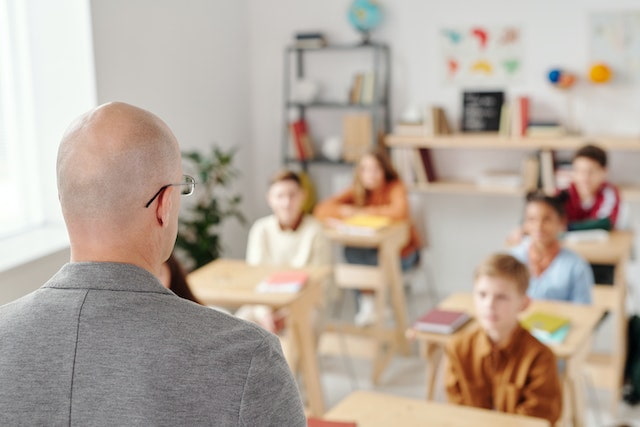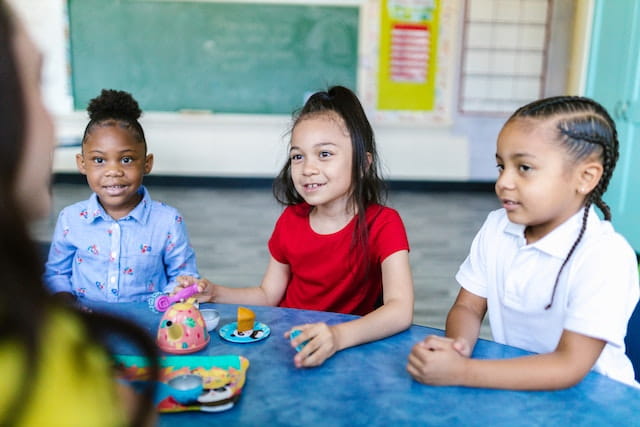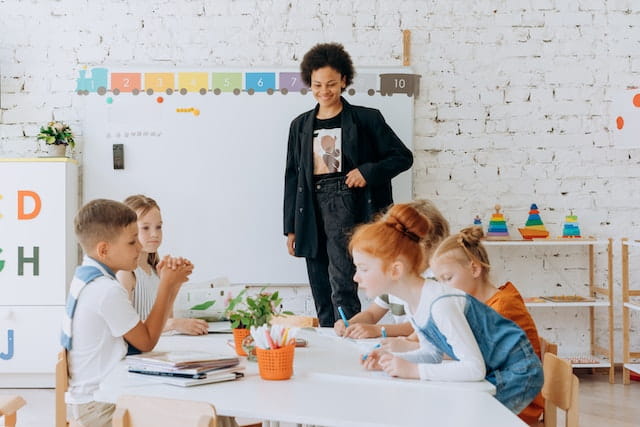Table of Contents
Classroom management refers to the strategies and techniques that teachers use to create a positive and effective learning environment for their students. It involves establishing rules and procedures, managing student behavior, and creating a supportive and engaging classroom climate. Effective classroom management includes a wide range of skills, such as effective communication, positive reinforcement, clear expectations, and consistent consequences for misbehavior. It also involves creating a sense of community within the classroom, building positive relationships with students, and promoting a culture of mutual respect and responsibility. The goal of classroom management is to create a safe, inclusive, and productive learning environment that supports student growth and success.
The Challenges of Classroom Management
Classroom management can be challenging for teachers, especially those who are new to the profession or who are working with difficult or challenging students. Some of the difficulties of classroom management include:
- Maintaining student engagement: Keeping students engaged and focused on the lesson can be difficult, especially when dealing with large class sizes, distractions, and boredom.
- Managing disruptive behavior: Dealing with disruptive or challenging behavior can be a major challenge for teachers, and can negatively impact the learning environment for all students.
- Balancing individual needs with the needs of the group: Teachers must balance the individual needs of their students with the needs of the group, which can be challenging when dealing with students with diverse learning styles and abilities.
- Time management: Teachers must manage their time effectively to cover all necessary content and activities, while also addressing student needs and managing behavior.
- Building positive relationships with students: Building positive relationships with students is essential for effective classroom management, but it can be challenging, especially when dealing with students who are disengaged, defiant, or unresponsive.
- Managing technology: With the increased use of technology in the classroom, teachers must manage student use of devices and ensure that they are used appropriately and effectively.
Overall, effective classroom management requires a combination of planning, organization, and interpersonal skills, and can be a difficult but rewarding aspect of teaching.
Here are some classroom management methods that will have amazing results with your classes:
1. Establish Clear Rules and Expectations
Establishing clear rules and expectations is crucial to maintaining a positive and productive classroom environment. It provides students with a framework for understanding what is expected of them, and creates a sense of structure and consistency that allows them to focus on learning. Without clear guidelines, students may become confused or frustrated, leading to disruptions and a lack of engagement.
An example of setting clear rules and expectations in the classroom could be establishing a no-cell-phone policy during class. You could communicate this expectation to your students on the first day of class, stating that cell phones must be turned off and put away during class time. You could also explain the reasoning behind this policy, such as the distraction factor and the importance of being fully present and engaged in the learning process.
To reinforce the importance of the rule, you could establish consequences for non-compliance, such as a warning or loss of participation points. By consistently enforcing this rule and communicating its importance to students, you are establishing a clear expectation for behavior and setting the tone for a productive classroom environment.

2. Use Positive Reinforcement
Positive reinforcement is a strategy used in the classroom to encourage and reinforce positive behavior. It involves rewarding students for their good behavior, efforts, and achievements, rather than punishing them for their negative behavior.
The use of positive reinforcement can be highly effective in promoting good behavior in the classroom. When students receive positive feedback and recognition for their efforts and achievements, they are more likely to repeat the behavior in the future. This can lead to a more positive and productive classroom environment.
One way to use positive reinforcement is by praising students for their efforts and achievements. It’s important to be specific in your praise, so students understand what they’re doing well and why it’s important. For example, instead of saying “Good job!”, you could say “Great work on that math problem! You showed excellent problem-solving skills.”
Another way to use positive reinforcement is by recognizing students’ strengths and talents. This can help boost their self-esteem and motivate them to continue to work hard. For example, if a student is particularly good at art, you could showcase their artwork in the classroom or give them an opportunity to share their talent with the class.
In addition to verbal praise and recognition, you can also use rewards and incentives to motivate students. These could include stickers, certificates, or extra free time. These rewards should be meaningful and appropriate for the age and interests of the students.
By focusing on the positive, you can create a classroom culture that celebrates growth and success, rather than just punishing negative behavior. This can help students feel more motivated, engaged, and invested in their learning, leading to a more positive and productive learning environment.
3. Use Active Listening
Active listening is a communication technique that involves fully concentrating on the speaker, comprehending their message, and responding appropriately. In the classroom, active listening means actively engaging with your students when they are speaking, showing interest in their thoughts and ideas, and using follow-up questions to clarify their meaning.
By using active listening, you can create a positive learning environment that encourages open communication, critical thinking, and mutual respect. It shows your students that you value their input and are willing to work collaboratively with them. Additionally, active listening can help prevent misunderstandings and conflicts from arising, as you are taking the time to fully understand what your students are saying.
For example, when a student comes to you with a concern or a question, actively listen to what they are saying. Make eye contact, avoid distractions, and focus on their words. Then, ask clarifying questions to make sure you understand their perspective. Once you have a clear understanding of their concern or question, respond thoughtfully and respectfully, taking their ideas into account. By using active listening in this way, you can build stronger relationships with your students and create a more positive learning environment.
4. Use Classroom Routines
Classroom routines are a series of procedures that are established to help students understand what is expected of them and how to behave in various situations in the classroom. Classroom routines can include entering the classroom, beginning and ending the day, transitioning between activities, and packing up. Establishing these routines can help students feel safe and secure in the classroom, know what to expect, and ultimately save instructional time by reducing disruptions.
It’s important to explicitly teach and model these routines to your students, so they understand the expectations and can practice them until they become automatic. This can include demonstrating how to enter and exit the classroom, how to begin and end the day, and how to transition between activities. You can also create visual aids such as posters or checklists to help reinforce the routines.
For example, if you want to establish a routine for entering the classroom, you might teach your students to line up quietly outside the door, enter the classroom in an orderly fashion, and then begin their morning work. You could model this routine for your students, and then have them practice it until they can do it automatically. You could also create a visual aid such as a poster that shows the steps of the routine, so students can refer to it if they need a reminder.
By establishing routines in the classroom, you can create a predictable and structured environment that helps students feel safe and secure. This, in turn, can lead to improved student behavior, greater engagement, and ultimately, better academic outcomes.
5. Differentiate Instruction
Differentiating instruction means adapting your teaching strategies and materials to meet the diverse needs of your students. This approach recognizes that students have different learning styles, strengths, challenges, and interests, and that instruction needs to be tailored to meet their individual needs.
To differentiate instruction, you may use a variety of methods, such as providing extra support for struggling students, challenging advanced learners, and using a variety of learning modalities and assessments. For example, you might offer additional one-on-one instruction to students who are struggling with a particular concept, while simultaneously offering more challenging material to advanced learners. You may also use various learning modalities, such as visual aids, hands-on activities, and technology, to engage students with different learning styles.
You may also use assessments that are designed to match students’ individual needs, such as formative assessments, exit tickets, and peer assessments. By providing differentiated instruction, you can create a classroom that is inclusive and supportive of all students’ learning needs. This can help reduce disruptive behavior and increase engagement and achievement.
For example, if you are teaching a math lesson, you may provide differentiated instruction by grouping students with similar abilities and providing each group with material that is appropriate for their level. You may also use manipulatives or visual aids to help struggling students understand the concept, while at the same time challenging advanced students with more complex problems.

6. Encourage Active Participation
Encouraging active participation is a teaching approach that involves promoting student engagement and involvement in the classroom. By actively participating in class, students are more likely to be invested in their own learning and feel a sense of ownership over their educational experience.
There are several strategies you can use to encourage active participation in the classroom. One strategy is to ask open-ended questions that require students to think critically and share their ideas. You can also incorporate small-group discussions or cooperative learning activities to encourage peer-to-peer interaction and collaboration. Hands-on activities, such as experiments or simulations, can also be effective in engaging students and promoting active participation.
For example, in a history class, you might use active participation strategies by asking students to discuss a particular event in small groups, and then have each group present their findings to the class. Another example could be a science class, where students engage in hands-on activities such as conducting experiments or building models to help them understand scientific concepts.
By encouraging active participation, you can create a dynamic and interactive classroom that promotes student engagement and learning. This approach can help prevent disruptive behavior by keeping students interested and focused on the material, and ultimately create a positive learning environment that supports student success.
7. Provide Clear Feedback
Providing clear feedback is an essential component of effective teaching. Clear feedback helps students understand their strengths and weaknesses, set goals, and monitor their progress. Feedback can come in many forms, including written comments, verbal feedback, and assessments.
Clear feedback is specific and actionable, providing students with information on what they did well and what they can improve. It is important to provide feedback in a timely and respectful manner, and to involve students in the process. You can encourage students to self-assess their work and set goals for improvement.
For example, in an English class, you might provide clear feedback on a student’s essay by highlighting specific areas where the student demonstrated strong critical thinking skills or where the student could improve their organization or clarity of writing. You can also provide actionable feedback by providing the student with tips on how to improve their writing skills and suggesting resources for additional support.
8. Foster a Growth Mindset
A growth mindset promotes the idea that abilities and intelligence are not fixed, but can be developed through effort and hard work. By fostering a growth mindset in the classroom, students are encouraged to take risks, learn from mistakes, and persist in the face of challenges.
To foster a growth mindset, you can emphasize the value of mistakes as opportunities for learning. This can involve reframing mistakes as a natural part of the learning process and highlighting how they can help students identify areas for improvement. You can also praise effort and persistence over innate ability, encouraging students to focus on the progress they are making rather than their natural talent.
For example, in a math class, you might praise a student who struggled with a problem but persisted and eventually found the correct solution. You can also encourage students to set goals and monitor their progress, providing support and guidance along the way. By fostering a growth mindset, students are encouraged to take ownership of their learning and develop a positive attitude towards challenges and setbacks.
Fostering a growth mindset can help prevent disruptive behavior by creating a supportive and collaborative learning environment. When students feel that they are valued for their effort and progress, they are more likely to engage in class and less likely to give up or act out.

9. Incorporate Movement and Brain Breaks
Incorporating movement and brain breaks into the classroom is a teaching strategy that involves providing students with frequent opportunities to move around and take short breaks from instruction. This strategy has been shown to have many benefits for students, including helping them maintain focus and attention, reducing restlessness and boredom, and increasing engagement and participation.
One example of a brain break activity is “Simon Says,” which is a game where the teacher gives commands and students follow them, such as “Simon says touch your nose” or “Simon says hop on one foot.” Another example is stretching exercises, where students stand up and stretch their arms and legs to help release tension and improve circulation.
Dancing is also a fun and effective way to incorporate movement and brain breaks into the classroom. You can play music and encourage students to dance along, which can be especially effective for younger students who may have more energy and need frequent breaks.
Incorporating movement and brain breaks into your teaching can be especially beneficial for students who struggle with attention or have difficulty sitting still for long periods. By providing opportunities for movement and breaks, you can help all students stay engaged and focused throughout the school day.
10. Create a Safe and Inclusive Classroom
Creating a safe and inclusive classroom involves promoting a culture of respect, acceptance, and inclusivity for all students, regardless of their background, culture, or identity. By creating an environment where students feel safe, respected, and valued, you can help them to focus on their learning and achieve their full potential.
One strategy for creating a safe and inclusive classroom is to establish clear anti-bullying policies. This means creating a zero-tolerance policy for bullying and harassment and communicating it to all students. It is also important to educate students on the negative effects of bullying and to encourage them to speak up if they witness or experience bullying.
Another strategy is to promote diversity and multiculturalism in the classroom. This can involve incorporating diverse perspectives into your teaching materials, celebrating cultural holidays and events, and encouraging students to share their own experiences and backgrounds. By promoting diversity and multiculturalism, you can help students to develop a better understanding and appreciation for different cultures and identities.
Creating a safe space for students to express themselves is also important. This can involve setting up a class agreement that outlines respectful communication and behavior, providing opportunities for students to share their thoughts and feelings, and creating a non-judgmental environment where students feel comfortable sharing their ideas.
An example of creating a safe and inclusive classroom is establishing a “circle time” at the beginning of each day, where students can share something about themselves or their culture. This can help to create a sense of community and promote understanding and acceptance among students. Additionally, creating a diverse classroom library with books that represent a variety of cultures and identities can help students feel seen and valued.
Final Words
Classroom management is essential because it creates a positive and productive learning environment for students. Effective classroom management techniques help to establish clear expectations for behavior and academic performance, build positive relationships between the teacher and students, and maintain consistent routines. When students feel safe, respected, and engaged in the learning process, they are more likely to be motivated and successful in their academic pursuits.
In addition, classroom management helps to prevent disruptive behavior and maximize instructional time. Teachers who have effective classroom management techniques in place can minimize disruptions and create a more focused and productive learning environment. This can lead to higher levels of academic achievement for students and greater job satisfaction for teachers.
Furthermore, classroom management is essential for creating a sense of community in the classroom. When teachers take the time to build positive relationships with their students and establish clear expectations and routines, they create a positive and supportive learning environment. This can help students feel more connected to their peers and their school, which can have a positive impact on their academic and social-emotional development.
Looking for more practical classroom management ideas? Check out this ebook:
Click on the image above to learn more.

